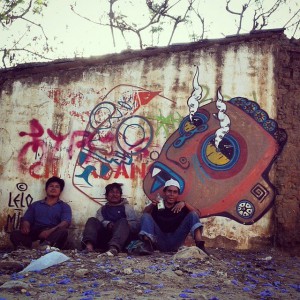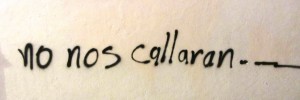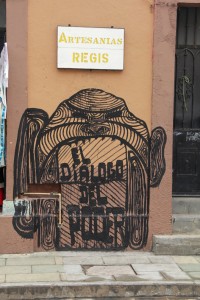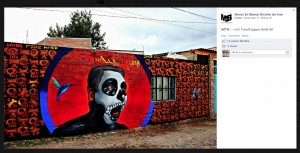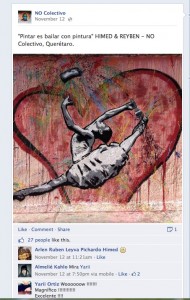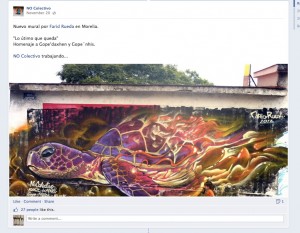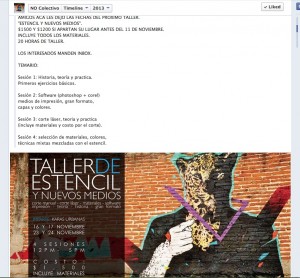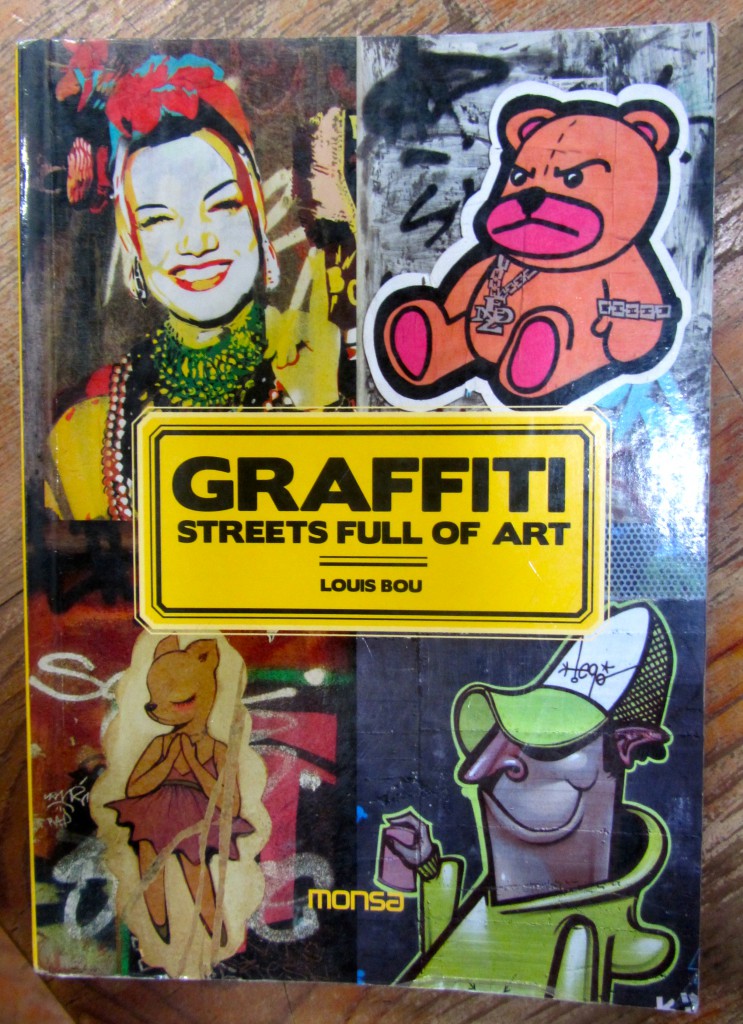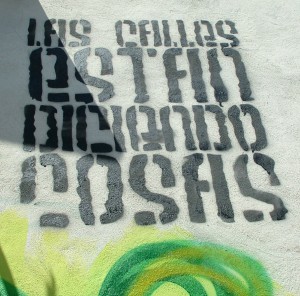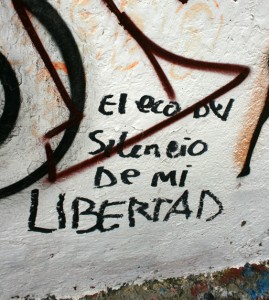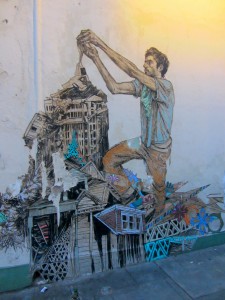Connecting modern street art to our theme of indigenous cultural survival might seem to require a modest effort, but really any evidence of a concern to protect, preserve, and celebrate local culture can illuminate those forces that have kept indigenous cultures so prominent in Oaxaca up to the modern day.

“From Our Roots is Born the Flower that Will Make the Conqueror Fall,” graphic art by Mojo, Oaxacan artist. (Photo, R. Haskett, 2014)
Above, artist Mojo implies that cultural preservation and flowering is one way to turn back the negative effects of conquest. He incorporates what appears to be a “feathered serpent” (Quetzalcoatl, in Nahuatl) in the design. Notice the shapes he utilizes, too, such as the curlicues coming off of the snake. These are reminiscent of the shapes archaeologist Ron Spores showed us in the mosaics at Mitla, which he said an informant associated with clouds and snakes. Feathers are associated with flying (and therefore skies, stars, the sun, clouds, rains), and serpents are associated with the surface of the earth. The feathered serpent might therefore be associated with land and rain water — crucial elements for agricultural fertility and for sustaining life.

“No” to Halloween; Long Live Our Traditions!
Defending the Day of the Dead traditions, Oaxaca, November 2013 (Photo, S. Wood)
Zaachila is a Zapotec town in the Valley of Oaxaca. According to the street-art photographer Itandehui Franco, street art in this community only sometimes incorporates pre-Columbian art themes. These masks have an indigenous look to them, but we are left to interpret the message. Are we seeing a sadness in the contemporary condition that makes life a struggle for people of notable indigenous heritage in Oaxaca? Is there an irony in the presence here of men of such heritage, whom we might take to be self-medicating with alcohol below the mural?
Curricula: High School Art
If you would like to use (or adapt) one of previous curricular units for teaching about street art or graffiti (in Spanish or as an art lesson, for example), please feel free to choose from the materials provided below. Please credit the teacher who made the unit.
- Nicole Caracciolo and Angela Guy, “Print as Protest”
- “Print as Protest” (PPT)
- “Print as Protest” (PDF)
- Nicole Caracciolo and Angela Guy, “Oaxacan Street Art: Modern Visual Communication”
- “Oaxacan Street Art” (PPTX)
- “Street Art” (PDF)
Copyright Free Photos for Instructional Use
Photos by Stephanie Wood
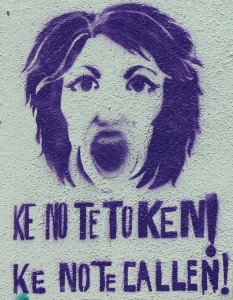
“Don’t let them touch you! Don’t let them silence you!” Graffiti/stencil in Chiapas, 2013. (E. Weisenbach)
Photos by Leslie Pulé on Flickr (agrees we can use these)
- “Red Star”
- “Leader Star” (Benito Juárez)
- “Quetzal”
- “Looking Round”
- “Lonely Simean Credo”
- “Televisada”
- “Play for Me“
- “No Tires”
- “Oaxaca Screaming”
Free Online Videos
- Curriculum Delictivo, Atake Visual 132K: Graffiti y estencil, Oaxaca (8 min.), in Spanish, on YouTube, about a group of youths and ASARO artists, making stencils of 1) a punk Emiliano Zapata (a leader of the Mexican Revolution of 1910); 2) a pretend bomb apparatus outside of banks in Oaxaca. From 2010.
- Resistencia Visual (5 min.), in Spanish, on YouTube
- Proyecto Chicatana, process of making a multi-colored stencil (1 min., 10 sec.), on YouTube
- Trazos de la Resistencia, Parte I (11 min. 37 sec.), in Spanish, on Facebook
- Trazos de la Resistencia, Parte II (11 min. 20 sec.), in Spanish, on Facebook
- Esquizofrenia 6ta Temporada: Oaxaca Hoy, Primera Parte (about the visual art collectives that came out of the 2006 social movement; featuring ASARO and Lapiztola, etc.) (8 min.) in Spanish, on YouTube
- Esquizofrenia 6ta Temporada: Oaxaca Hoy, Segunda Parte (featuring ArteJaguar and a female rapper, etc.) (6 min. 31 sec.) in Spanish, on YouTube
Facebook Stills
IAGO Free Library
The Instituto de Artes Gráficos de Oaxaca on Macedonio Alcalá offers a free library with books of relevance for a project about street art and graffiti. See, for example, the book below by Louis Bou, which will help contextualize Oaxacan street art.
Essays/Articles/Catalogues
(free, online, full-text)
- Itandehui Franco Ortiz, “El deleite de la transgresión: Graffiti y gráfica política callejera en la ciudad de Oaxaca,” (Licentiate’s Thesis in Ethnohistory, Escuela Nacional de Antropología e Historia, Mexico City, 2010) (in Spanish, but the images are worth viewing even if you do not read Spanish)
- Callegenera (“The street generates…”) is a catalogue from a month-long encounter of street artists that took place in Monterey, Mexico, in 2013. It was perhaps the third or fourth such gathering, and there are more to come. One can see the names of the artists, when they were born, and examples of their work. (Note, however, that one artist is said to have been born in 1990, and he is actually older than that.) As this shows, the movement is very large.
- Arte Urbano, catalogue about contemporary “murals” in Michoacán, 2011–12. The use of the term murals is strategic, perhaps, because of the hallowed tradition of muralism in Mexico in the early twentieth century.
- Tlakolulokos, a Oaxacan group’s website; these are youth who took part in the 2006 social movement, in the trenches, inside the barricades (“las barricades”), and then emerged about 2008 to express themselves more in artistic realms.
- James Cockroft, “Street Art and the Splasher: Assimilation and Resistance in Advanced Capitalism”
- Ivan Arenas, “The Social Life of Collective Memory: Oaxaca’s Material Reminders and Historical Remainders”
- Gina Mejía, “Imprime dramatismo y tragedia,” (article in Spanish from El Imparcial, 9 Dic. 2013, about the ASARO artist César Chávez)
Must Write for Permission to Use
- ASARO Colectivo on Facebook
- Itandehui Xiaj Nikté on Facebook
- Yescka Guerrilla Art on Facebook
- Cesar Chavez on Facebook
- Arte Jaguar on Facebook
- Aler Arte Jaguar on Facebook
- Lori Cottle’s “Street Art in Mexico” Middle School Art Lesson
- Video, “Graffiti from Oaxaca” (in Spanish; language caution)
- YouTube piece showing youth putting art on wall in Oaxaca
- Curbs and Stoops: Lapiztola
- Julius, “Laid Back” gallery
- Marissa Travels Blog: Oaxaca Street Art Competition, July 2008
- Bel’s Nook
- Wanderoo
- Impose Magazine
- Sarah + Marc
- Christian Science Monitor article
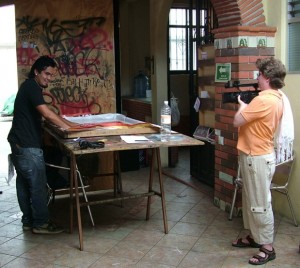
Yescka in the studio that was on Calle Fiallo, Oaxaca; Gabriela Martínez filming him at work (Photo, S. Wood)
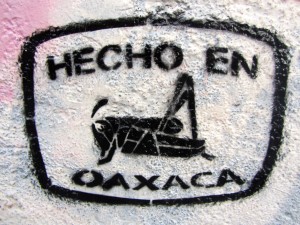
An ASARO graphic piece emphasizing “Made in Oaxaca” and showing a grasshopper (an item in the pre-Columbian diet). Made by Yescka. (Photo, S. Wood, Nov 2013)

